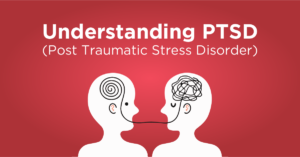In today’s fast-paced world, the prevalence of trauma and post-traumatic stress disorder (PTSD) has been on the rise. The need for professional help to address these issues is more crucial than ever. If you or someone you know is seeking a trauma PTSD therapist or wondering, “Is there a PTSD trauma therapist near me?” – you’re not alone. In this comprehensive guide, we will delve into the world of trauma therapy, PTSD treatment, and how to find the right therapist to support your healing journey.
Contents
Understanding Trauma and PTSD

Before we dive into the role of a trauma PTSD therapist, it’s essential to understand what trauma and PTSD are:
- Trauma: Trauma is an emotional response to a distressing event or series of events that overwhelms an individual’s ability to cope. Traumatic experiences can vary widely, from physical violence and natural disasters to emotional abuse and accidents. Trauma can affect people of all ages and backgrounds.
- Post-Traumatic Stress Disorder (PTSD): PTSD is a mental health condition that may develop after a person has experienced or witnessed a traumatic event. Symptoms of PTSD can include flashbacks, nightmares, severe anxiety, and emotional numbness. These symptoms often interfere with a person’s daily life and functioning.
The Role of a Trauma PTSD Therapist
Trauma PTSD therapists are mental health professionals who specialize in helping individuals who have experienced trauma and are struggling with PTSD. Their role is multifaceted and involves a range of responsibilities:
- Assessment: The first step in therapy is to assess the client’s history, experiences, and symptoms. Trauma PTSD therapists work to understand the unique circumstances surrounding the trauma and the individual’s specific needs.
- Diagnosis: Once the assessment is complete, therapists diagnose PTSD or related trauma-related disorders, determining the severity of the condition.
- Treatment Planning: Based on the assessment and diagnosis, therapists create personalized treatment plans. These plans may include various therapeutic approaches tailored to the individual’s needs.
- Psychoeducation: Therapists educate clients about trauma and PTSD, helping them understand their symptoms and how trauma affects their mental health.
- Trauma-Focused Therapy: Trauma PTSD therapists use evidence-based therapeutic modalities like Cognitive-Behavioral Therapy (CBT), Eye Movement Desensitization and Reprocessing (EMDR), and Trauma-Focused Cognitive Behavioral Therapy (TF-CBT). These therapies help individuals process traumatic memories, reduce symptoms, and build resilience.
- Emotional Regulation: Therapists teach clients techniques for managing overwhelming emotions and stress, helping them regain control over their lives.
- Coping Strategies: Clients learn healthy coping mechanisms to deal with triggers and distressing memories.
- Support and Validation: Therapists provide a safe and non-judgmental space for clients to express their feelings, fears, and concerns, validating their experiences.
Qualifications of a Trauma PTSD Therapist

Becoming a qualified trauma PTSD therapist requires a combination of education, training, clinical experience, and ongoing professional development. The qualifications for a trauma PTSD therapist can vary somewhat by region and the specific requirements of the therapy practice, but here are the general qualifications and steps involved:
Education:
- Bachelor’s Degree: Begin by earning a bachelor’s degree in a relevant field such as psychology, social work, counseling, or a related discipline. This typically takes four years to complete.
- Master’s Degree: Most trauma PTSD therapists hold a master’s degree (e.g., Master of Social Work, Master of Counseling, Master of Psychology, or a similar degree) from an accredited institution. This usually takes an additional two to three years of study.
Licensure:
- Obtain State Licensure: After completing a master’s degree program, individuals typically need to become licensed to practice as a therapist in their state or country. Licensure requirements vary by location but often. These include passing a licensing exam, completing a certain number of supervised clinical hours, and fulfilling other state-specific requirements.
- Maintain Licensure: Licensed therapists must adhere to their state’s continuing education requirements to maintain their licensure. This ensures they stay current with best practices and treatment methods.
Specialized Training:
- Trauma-Focused Therapies: To work specifically with trauma and PTSD clients, therapists often pursue specialized training in trauma-focused therapies. These may include Cognitive-Behavioral Therapy (CBT) for trauma, Eye Movement Desensitization and Reprocessing (EMDR), Trauma-Focused Cognitive Behavioral Therapy (TF-CBT), and others.
- Certification: Some therapists seek certification in specific trauma therapies, which may require additional training and supervised practice hours.
Clinical Experience:
- Supervised Hours: Many licensing boards require therapists to accumulate a certain number of supervised clinical hours before becoming fully licensed. These hours often include working with clients who have experienced trauma.
- Internships and Residencies: Completing internships or residencies in settings that focus on trauma and PTSD. These are such as trauma centers or veterans’ hospitals, can provide valuable experience.
Techniques Used by Trauma PTSD Therapist
Trauma PTSD therapists employ a variety of techniques and therapeutic approaches to help individuals cope with and recover from trauma and Post-Traumatic Stress Disorder (PTSD). The choice of techniques often depends on the therapist’s training, the client’s unique needs, and the specific goals of therapy. Here are some common techniques used by trauma PTSD therapists:
- Trauma-Focused Cognitive-Behavioral Therapy (TF-CBT): TF-CBT is a widely used and evidence-based approach for treating trauma and PTSD, particularly in children and adolescents. It focuses on helping clients understand the connections between their thoughts, feelings, and behaviors related to the traumatic experience. Therapists teach coping skills, and relaxation techniques, and help clients reframe and process traumatic memories.
- Eye Movement Desensitization and Reprocessing (EMDR): EMDR is an evidence-based therapy that helps individuals process traumatic memories and reduce distressing symptoms. During EMDR sessions, clients focus on a specific memory while tracking the therapist’s hand movements or other forms of bilateral stimulation. This process is believed to help reprocess traumatic memories and reduce their emotional charge.
- Exposure Therapy: Exposure therapy involves gradually and safely confronting trauma-related triggers or memories to reduce anxiety and avoidance behaviors. The goal is to desensitize the individual to the traumatic stimuli. For example, a therapist might expose a combat veteran to simulated combat sounds or a sexual assault survivor to controlled reminders of the assault.
- Mindfulness and Relaxation Techniques: Mindfulness practices, such as meditation and deep breathing exercises, help clients become more aware of their present-moment experiences and manage overwhelming emotions. These techniques can be particularly useful in reducing symptoms like anxiety and hyperarousal associated with PTSD.
- Grounding Techniques: Grounding techniques are designed to help individuals stay connected to the present and reduce dissociation or flashbacks. These techniques may include focusing on the five senses (sight, sound, touch, taste, and smell) to anchor oneself in the present moment.
- Cognitive Restructuring: Therapists work with clients to identify and challenge negative or distorted thought patterns related to their traumatic experiences. By replacing these thoughts with more balanced and rational ones, individuals can reduce anxiety and distress.
- Art and Expressive Therapies: Some individuals find it challenging to verbalize their trauma experiences. Art therapy, music therapy, and other expressive therapies can provide alternative ways to process and express their emotions and experiences.
- Narrative Therapy: This approach helps clients reframe their trauma narrative and view themselves as survivors rather than victims. Therapists assist clients in reconstructing their life stories in a way that empowers and validates their resilience.
- Group Therapy: Group therapy sessions allow individuals with similar experiences to share and support one another. Group therapy can provide a sense of community, reduce feelings of isolation, and offer opportunities for peer validation and feedback.
- Medication Management: In some cases, trauma PTSD therapists may work in conjunction with psychiatrists or medical professionals. This is to prescribe and monitor medication for clients with severe PTSD symptoms. Medications like antidepressants or anti-anxiety drugs can be used to alleviate specific symptoms.
How To Consult a Trauma PTSD Therapist?

Consulting a trauma PTSD therapist is an important step toward healing and recovery if you or someone you know is struggling with trauma-related issues. Here’s a step-by-step guide on how to consult a trauma PTSD therapist:
- Self-Assessment: Start by assessing your own or the individual’s needs. Consider the following questions:
- Do you or the individual experience symptoms of trauma or PTSD, such as flashbacks, nightmares, anxiety, or emotional numbness?
- Has there been exposure to a traumatic event or ongoing traumatic stress?
- Are these symptoms interfering with daily life, relationships, or overall well-being?
- Talk to Your Primary Care Physician: If you or the individual has a primary care physician, discuss the symptoms and concerns with them. They can provide a referral to a mental health specialist or a list of recommended therapists.
- Insurance and Budget: Check your health insurance policy to determine what mental health services are covered. Understanding your financial constraints will help you find therapists within your budget. If you don’t have insurance, there may be low-cost or sliding-scale therapy options available in your area.
- Research: Use online resources, directories, and mental health websites to research trauma PTSD therapists in your area. You can also ask for recommendations from friends, family, or healthcare professionals. Look for therapists with experience and specialization in trauma and PTSD.
- Contact Potential Therapists: Reach out to several potential therapists by phone or email to inquire about their services, availability, and fees. It’s essential to ask questions about their approach to therapy, experience with trauma, and whether they accept your insurance.
Qualities of a Trauma PTSD Therapist
Here are some of the key qualities of a trauma PTSD therapist:
- Empathy: Empathy is the ability to understand and share the feelings of another person. A trauma PTSD therapist must be empathetic, showing genuine care and concern for their client’s emotional well-being. This quality helps create a safe and supportive therapeutic environment.
- Active Listening: Active listening involves not only hearing what clients say but also understanding the underlying emotions and meanings behind their words. Therapists who actively listen can provide more meaningful responses and validation to their clients.
- Non-Judgmental Attitude: Clients may share deeply personal and distressing experiences in therapy. A non-judgmental attitude is essential for creating a safe space where clients feel comfortable opening up without fear of criticism or condemnation.
- Patience: Healing from trauma can be a lengthy and challenging process. Trauma PTSD therapists need to be patient and allow clients to progress at their own pace, respecting their readiness to explore and address traumatic experiences.
- Cultural Sensitivity: Clients from diverse cultural backgrounds may have unique perspectives on trauma and healing. A culturally sensitive therapist respects and understands these differences, ensuring that therapy is culturally appropriate and relevant.
Conclusion
Trauma PTSD therapists play a vital role in helping individuals recover from traumatic experiences and manage the debilitating symptoms of PTSD. Their expertise, compassion, and evidence-based interventions make a significant difference in the lives of those who have suffered trauma.
If you or someone you know is struggling with trauma or PTSD, seeking the guidance of a qualified trauma PTSD therapist can be a crucial step toward healing and reclaiming a sense of well-being. Remember, there is hope, and with the right support, recovery is possible.
Online therapists are increasingly important in today’s world because they provide a convenient and accessible way for people to receive mental health support and treatment. Visit TherapyMantra for an affordable Online Therapy: Book a trial Online therapy session.


